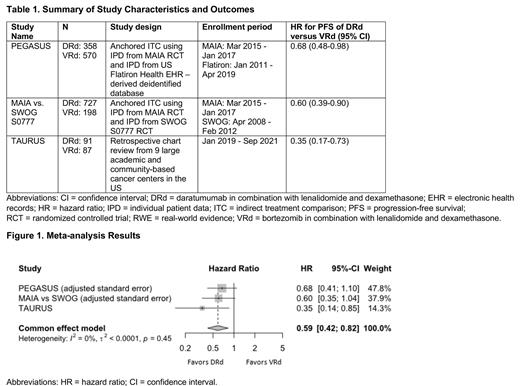Background: Daratumumab in combination with lenalidomide and dexamethasone (DRd) and bortezomib in combination with lenalidomide and dexamethasone (VRd) are currently the only guideline-recommended preferred regimens for primary treatment of transplant-ineligible (TIE) patients with newly diagnosed multiple myeloma (NDMM). The lack of direct head-to-head trials comparing these two preferred regimens makes it difficult for the treating physicians to select optimal frontline treatment for TIE NDMM patients. A number of network meta-analyses comparing the existing therapies in this patient population have been published; however, these studies have certain limitations such as not sufficiently accounting for heterogeneity among trials (MAIA trial included TIE patients only while SWOG S0777 had a mix of TIE and transplant not intended patients), variable duration of follow-up, inclusion of treatments not used in routine clinical practice in the US, and use of aggregate level data from the pivotal trials. Therefore, the current systematic literature review and meta-analysis (MA) aims to identify and aggregate clinical evidence specifically comparing DRd versus VRd as first-line (1L) treatment for TIE patients with NDMM across a wider evidence base, including indirect treatment comparisons and real-world evidence studies.
Methods: The protocol was developed in alignment with the PRISMA for systematic review protocols (PRISMA-P) statement. The Population, Intervention, Comparator, Outcome, Study design (PICOS) framework was used to develop the search strategy and structure the reporting of the eligibility criteria. The search strategy was developed by a medical information specialist and peer reviewed. Ovid MEDLINE ®, Embase, and the Cochrane Library databases were searched from January 2019 to June 2023 along with key congresses (International Myeloma Society, American Society of Hematology, European Hematology Association, American Society of Clinical Oncology) from January 2018 to June 2023. These dates were implemented to identify recent literature and to align with the US Food and Drug Administration (FDA) and European Medicines Agency (EMA) approvals of DRd for TIE NDMM. Study eligibility was assessed according to pre-specified criteria. Randomized clinical trials (RCTs) and adequately adjusted, non-randomized comparative studies comparing DRd versus VRd for treatment of adult TIE patients with NDMM were identified for inclusion. The primary outcome of interest was progression-free survival (PFS). Risk of bias was assessed using the National Institute for Health and Care Excellence (NICE) checklist. The feasibility of conducting a MA of the included studies was assessed. A frequentist approach was conducted for the MA considering the unit of analysis, varying treatment effects, and risk of bias. The study protocol is available on PROSPERO (CRD42023435119).
Results: Of 863 records screened, 4 were included (1 publication and 3 conference abstracts), representing 3 unique studies. Two studies were indirect treatment comparisons and 1 was a retrospective chart review. In each study, TIE NDMM patients treated with DRd had a significantly lower risk of progression/death compared to those treated with VRd (Table 1).
After qualitatively reviewing the evidence base and assessing between-trial clinical and methodological heterogeneity, it was considered feasible to conduct a MA of PFS including all 3 identified studies. Results from the MA (Figure 1) suggest that patients treated with DRd had a lower risk of progression/death compared to those treated with VRd (hazard ratio: 0.59, 95% confidence interval: [0.42-0.82]).
Conclusions: Findings from the MA indicate that DRd is associated with a lower risk of disease progression/death compared to VRd as 1L treatment for TIE patients with NDMM. These findings could help inform the selection of optimal 1L treatment for these patients in the absence of head-to-head clinical trials.
Disclosures
Gordan:Florida Cancer Specialists: Current Employment. Medhekar:Janssen Scientific Affairs, LLC: Current Employment, Current equity holder in publicly-traded company. Fu:Johnson & Johnson: Current Employment, Current equity holder in publicly-traded company. Ramirez:EVERSANA: Current Employment. Bonar:EVERSANA: Current Employment. Nguyen:EVERSANA: Consultancy. Spence:EVERSANA: Current Employment. McTavish:EVERSANA: Current Employment. Disher:EVERSANA: Current Employment. Kaila:Janssen Scientific Affairs, LLC: Current Employment, Current equity holder in publicly-traded company.


This feature is available to Subscribers Only
Sign In or Create an Account Close Modal